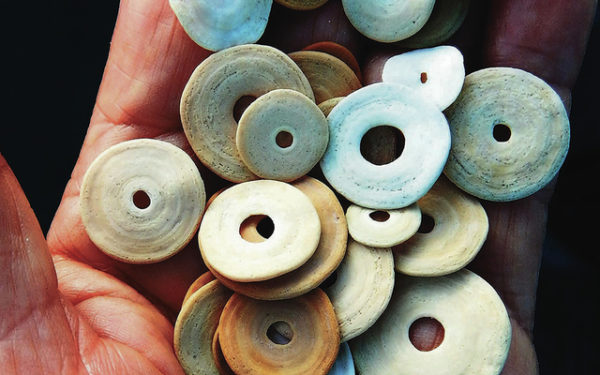Published in the Ocean Watch column, Honolulu Star-Advertiser © Susan Scott
May 28, 2016
Goldsmith Island, Queensland, Australia >> While sailing north through the reefs and islands of Great Barrier Reef National Park, our routine is to sail in the morning, choose one of the nearly endless protected island anchorages, stop there for the night and explore. Although each island is rich with its own charming gangs of kangaroos, parrots and coral-ringed islets, we rarely spend more than one night in the same place. We just never know what this amazing park has in store for us down the line.
 Australians call these foram shells mermaid’s pennies;
Australians call these foram shells mermaid’s pennies;
they’re common on the Great Barrier Reef.
©2016 Susan Scott
One day last week, for instance, after anchoring in a picture postcard bay, we headed to shore in our dinghy and struck it rich. Countless pennies lay scattered over the white sand.
Mermaid’s pennies, that is, according to Australians. To me they were puka shells, but odd ones. It looked as if someone had spilled a truckload of washers on the beach.
The shell washers ranged in diameter from so tiny I could barely pick them up to about an inch wide. The holes in the center also varied from none to most of the shell. Nor were these disks pure white and wavy like puka shells. Their flat surfaces came in all shades of gray, brown and cream. The shells are from a species of marine creature called a foraminifera, foram for short. Being close to the beginning of the food web, forams are vital for healthy oceans, and to human enterprises as well. Egypt’s pyramids are made of zillions of calcium carbonate foram shells squished together over geologic time. Geologists also use foram deposits as clues to the location of underground oil.
Forams deliver beauty as well, decorating some of the most exquisite shorelines on the world. Beaches in Hawaii, Palau, Bermuda and more are carpets of forams finely ground by ocean waves.
Forams are animals like bacteria are animals. They eat, reproduce, walk around, prey on other organisms and die. But even the largest ones are only a single cell. They’re like amoebas with shells arranged in countless shapes of disks, spheres, spirals and tubes. Most are too small to see with the naked eye, which is what makes the mermaid’s pennies (and the white puka shells of the South Pacific) special.
Forams line all ocean floors and drift in marine plankton in astronomical numbers. In his study, one researcher found an estimated 70,000 forams per square yard on the ocean bottom. The number is on the low side for some areas. In one place, “foram ooze” was 6,600 feet thick.
At this writing, we’ve explored beaches and reefs of about 10 islands and found shells of snail species we know and many we don’t. Curiously, we’ve seen no more mermaid’s pennies, but the handful I have make me feel rich indeed.